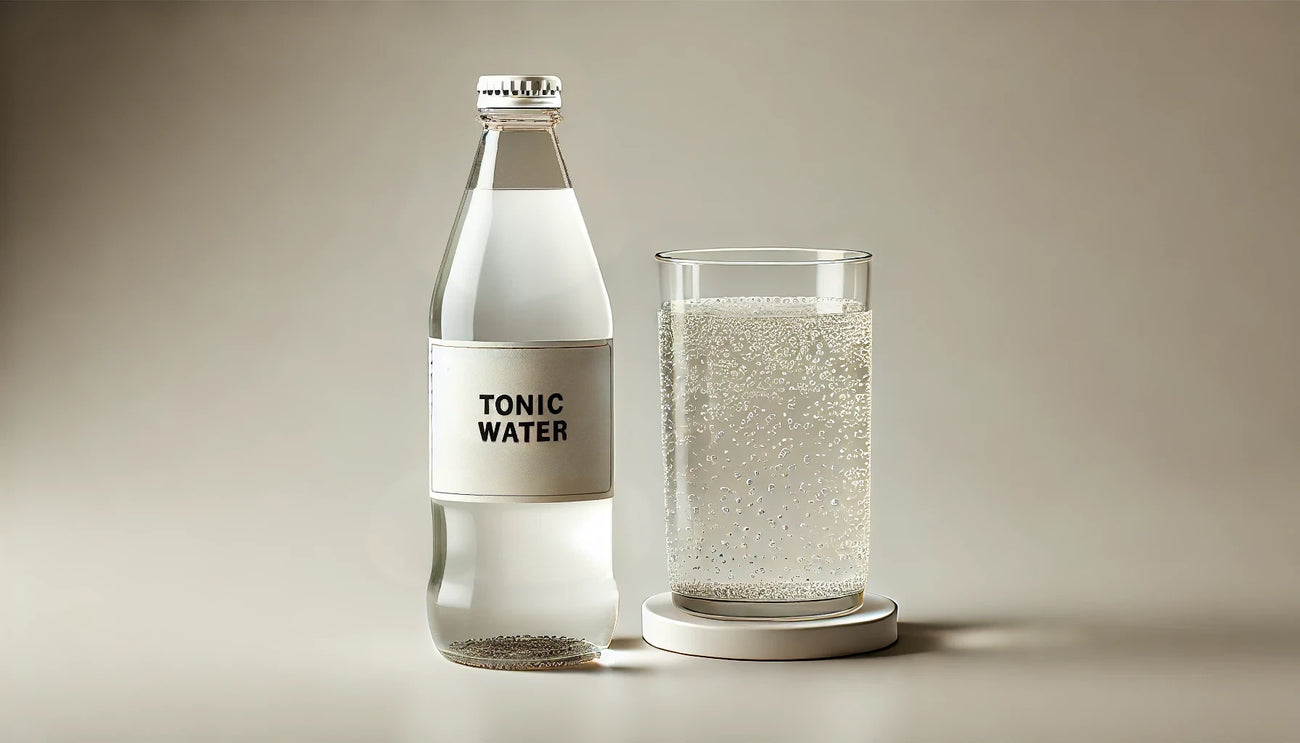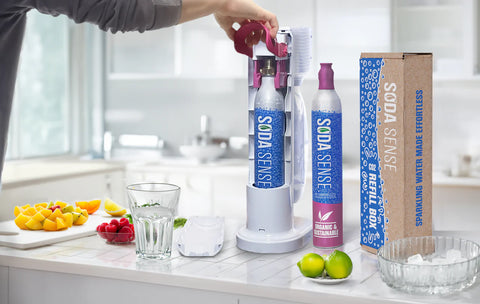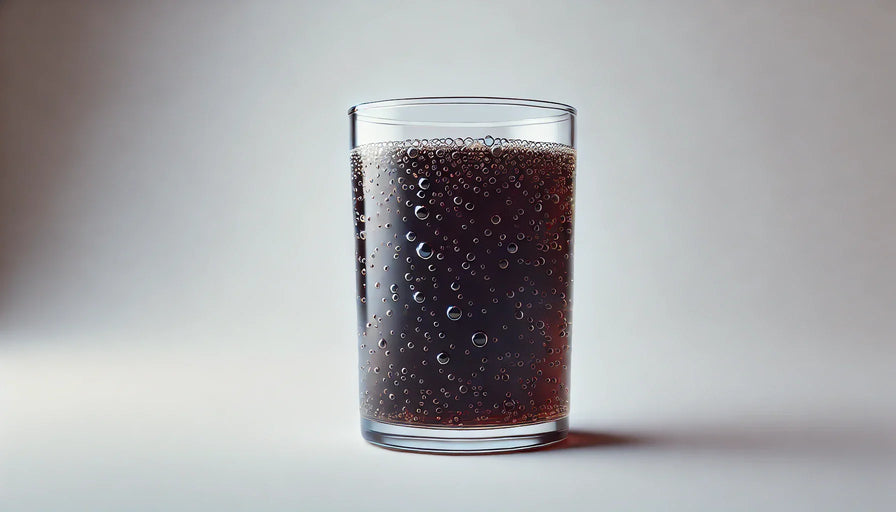
Tonic Water vs Sparkling Water: What's the Difference?

What's the difference between tonic water vs sparkling water?
Tonic water and sparkling water differ primarily in their ingredients and taste. Tonic water is commonly used as a mixer in cocktails, especially with gin. Although both are carbonated, tonic water contains added ingredients that alter the taste and nutritional value.
Despite their bubbly appearance, tonic water and sparkling water differ greatly in ingredients, taste, and usage.
In this blog, we'll delve into the key distinctions between tonic water and sparkling water, guiding you to make an informed choice for your next drink—whether you're crafting a cocktail or simply savoring a refreshing sip.
There are a variety of carbonated waters on the market so knowing the facts is key!
Table of contents
Is tonic water acidic?
Yes, tonic water is acidic. It typically has a pH level ranging from 2.5 to 3.5, primarily due to the presence of carbonic acid and citric acid. This makes tonic water more acidic than regular tap water, which usually has a pH level of around 7.
Sparkling water typically has a pH level between 3 and 4, which means that tonic water is slightly more acidic than sparkling water. However, compared to other soft drinks like cola or lemonade, tonic water tends to be less acidic.
Ingredients in tonic water
Understanding the ingredients in tonic water can help you appreciate its unique flavor and how it complements various cocktails. Unlike sparkling water, tonic water includes several added components that contribute to its distinctive taste and characteristics.
Let's delve into what exactly makes up tonic water:
- Carbonated water
- High fructose corn syrup (sugar)
- Citric acid
- Quinine
- Natural flavors
- Sodium benzoate
- Sodium citrate
As you can see, there is far more than meets the eye in the tonic water you find on supermarket shelves. Knowing these ingredients can help you make informed decisions on use and time and place for tonic water vs sparkling water.
Related read: The Origin of Tonic Water
To fully understand these ingredients, let's break down each further individually.

Carbonated water
The foundation of tonic water is carbonated water, which gives the drink its delightful fizz. This carbonation imparts a refreshing sensation, making tonic water an ideal mixer for a variety of spirits.
High fructose corn syrup
Tonic water often contains high fructose corn syrup or other sweeteners like cane sugar. This addition gives the water a slight sweetness, balancing the bitterness from other ingredients.
It's important to note the calorie content associated with these sweeteners, making tonic water less suitable for those monitoring their sugar intake.
Citric acid
Citric acid is introduced to give tonic water its tangy and slightly sour flavor. This acidity not only enhances the overall taste but also serves as a preservative to prolong the shelf life of the beverage.
Quinine
Quinine is the ingredient that sets tonic water apart from other carbonated drinks. Derived from the bark of the cinchona tree, quinine gives tonic water its characteristic bitter taste.
Historically, quinine was used to treat malaria, but in tonic water, it's present in minimal amounts for flavor rather than medicinal purposes.
Natural flavors
Natural flavors are added to tonic water to enhance its overall taste profile. These can include botanical extracts like lemongrass or cucumber, providing subtle flavor notes that can elevate the drinking experience, especially when used in cocktails.
Sodium benzoate
Sodium benzoate is a preservative used in tonic water to inhibit the growth of bacteria, yeast, and fungi. Its inclusion ensures that the tonic water remains safe to drink over time, even after opening.
Learn more about the differences between tonic water and soda water!
Sodium citrate
Sodium citrate is employed to regulate the acidity of tonic water, counterbalancing the tartness of citric acid. It maintains the desired pH level, ensuring a consistent and enjoyable flavor with every sip.
Related read: Tonic water vs club soda: What's the difference?

Sparkling water compared to tonic water
- Sparkling water is much simpler in composition than tonic water. It generally consists solely of carbonated water, with no added sweeteners, preservatives, or flavorings. This simplicity makes it an appealing option for those seeking a natural and unadulterated beverage.
- The taste of sparkling water is clean, crisp, and devoid of any additional flavors or sweetness. Unlike tonic water, sparkling water does not have the bitterness imparted by quinine.
- Sparkling water is often viewed as a healthier alternative to sugary sodas and other sweetened beverages like tonic water.
- While tonic water is predominantly used as a cocktail mixer, sparkling water is more versatile in its applications. It can be enjoyed straight from the bottle, used as a base for mocktails and cocktails, or combined with fruit juices and herbal infusions for a refreshing drink.
- Sparkling water was first invented in 1767 by Joseph Priestley. As a result, bubbly tonic water was invented in the early 19th century specifically as a way to prevent and treat malaria
In summary, while both tonic water and sparkling water share the common trait of carbonation, they are distinct in their ingredients, taste, and common uses.
Related read: What's the difference between seltzer vs sparkling water?
Nutritional differences
Understanding the nutritional values of tonic water and sparkling water can help you make healthier choices based on your dietary needs and preferences.
Sparkling Water
Sparkling water is known for its simplicity and minimal nutritional content. Here's a basic breakdown:
- Calories: 0
- Sugars: 0g
- Carbohydrates: 0g
- Sodium: 0mg
- Other Nutrients: None
As you can see, sparkling water is a calorie-free, sugar-free, and sodium-free option, making it an ideal choice for those looking to stay hydrated without added calories or nutrients.

Tonic Water
Tonic water, on the other hand, includes several additional ingredients that contribute to its nutritional profile. The numbers below are per 8 fl oz (240mL):
- Calories: Approximately 83
- Sugars: 21.5g
- Carbohydrates: 22g
- Sodium: 20mg
- Other Nutrients: Contains small amounts of quinine
Tonic water's added sugars and calories make it a less suitable choice for those monitoring their calorie intake or trying to reduce sugar consumption.
In summary, while sparkling water provides a straightforward, low-calorie hydration option, tonic water offers a more flavorful but higher-calorie and higher-sugar alternative.
Club soda, interestingly enough, is also calorie free similarly to sparkling water. However, they also differ in ingredients and production process.
How it is made: Sparkling water vs tonic water
Production process of sparkling water
The production of sparkling water is relatively simple and straightforward. Industrially, it begins with the purification of water to ensure it’s free from contaminants. The clean water is then carbonated by injecting it with carbon dioxide gas under high pressure.
This carbonation process can vary slightly depending on whether it is naturally occurring, as in some mineral waters, or artificially added.
For those interested in making sparkling water at home, it can be easily achieved using a soda maker, which carbonates water by infusing it with CO2 from a replaceable cartridge.

Production process of tonic water
The production of tonic water is more complex due to additional ingredients and steps. High-quality water is sourced, much like in sparkling water production.
Various ingredients are then combined in precise proportions, including carbonated water, high fructose corn syrup or other sweeteners, citric acid, quinine, natural flavors, and preservatives like sodium benzoate and sodium citrate.
Quinine, derived from the bark of the cinchona tree, is added to give tonic water its distinctive bitter taste. Carbon dioxide is infused into the mixture to create the fizz.
Finally, the tonic water mixture is bottled or canned, ensuring that the carbonation and flavors are well-preserved.
Key takeaways
- Sparkling water is a simple, unflavored carbonated beverage, calorie-free, and suitable for those seeking a natural hydration option.
- Tonic water is a flavored carbonated drink with added sugars, quinine, and other ingredients, making it less suitable for low-calorie diets.
- Both beverages share carbonation but differ in ingredients, taste, and common uses; sparkling water is versatile, while tonic water is typically used in cocktails.
- Sparkling water is straightforward to produce, often just water and CO2, whereas tonic water involves a more complex process with multiple added components.
- Understanding the nutritional differences can help consumers make healthier choices based on their dietary needs and preferences.
Recommended reading

How to Give Back During Thanksgiving 2025
Key takeaways Thanksgiving is a time to express gratitude and share with those in need. From volunteering at local shelters to donating food and essentials, there are numerous ways to give back to...

What Does Carbonation Do to Your Body?
What does carbonation do to your body? Carbonation alone typically has minimal effects; however, it can cause bloating and discomfort for some, and it may worsen acid reflux due to carbon dioxide ...

What Are the Health Benefits of Sparkling Water?
Summary Sparkling water isn't just a refreshing drink—it comes with surprising health benefits too. From aiding digestion to improving hydration, discover how sparkling water can be a healthy addi...